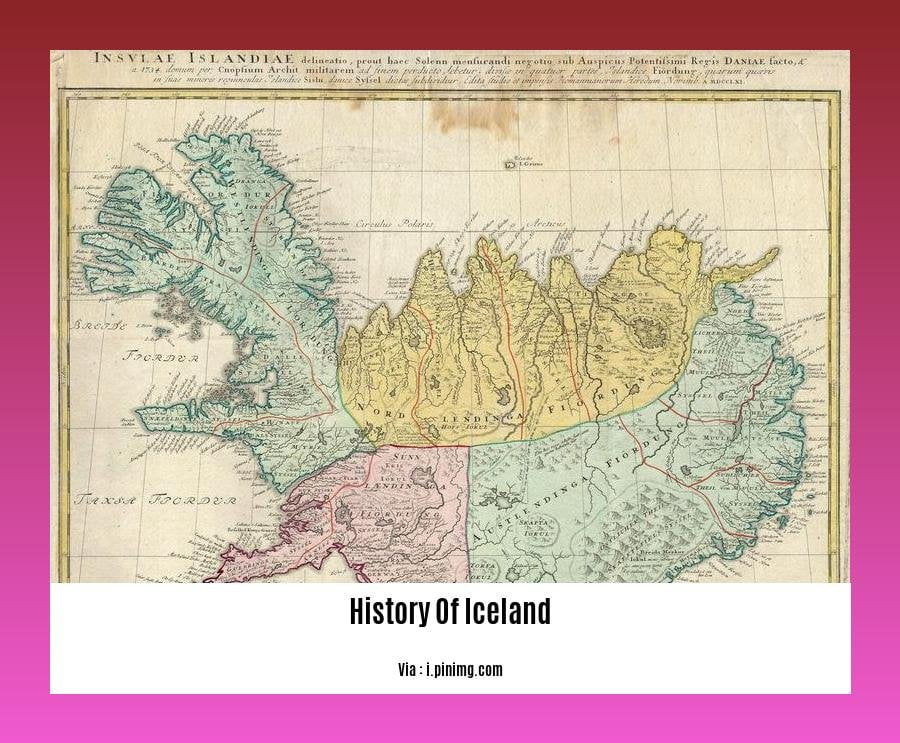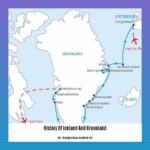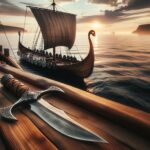Embark on a historical odyssey through the captivating land of Iceland, where breathtaking landscapes intertwine with tales of ancient sagas and Viking lore in [- Unveiling the Tapestry of Time: A Journey Through the History of Iceland]. Join us as we delve into the annals of this Nordic gem, exploring the pivotal events and cultural influences that have shaped its unique identity. From the age of settlement and the birth of Althing to the era of exploration and modern independence, Iceland’s story is a tapestry of resilience, innovation, and the indomitable spirit of its people.
Key Takeaways:
Norse and Celtic adventurers from Norway arrived in Iceland during the Viking Age, leading to its founding.
A unique system of self-government was established, involving local assemblies (“things”) and a national parliament (“Althing”).
Iceland became part of Norway and later Denmark through various alliances but retained its distinct language, culture, and legal traditions.
Iceland encountered challenges such as volcanic eruptions, diseases, pirate raids, witch hunts, and poverty, but produced noteworthy literature, art, and scientific achievements.
Iceland gained independence from Denmark through a peaceful referendum in 1944, becoming a republic with a democratic constitution and a president.
Today, Iceland is a prosperous and modern country renowned for its natural beauty, renewable energy initiatives, social welfare, and cultural diversity.
The Althingi, Iceland’s legislature, dates back to 930, making it one of the oldest in the world.
Iceland united with Norway in 1262 and later with Denmark in 1380.
History of Iceland
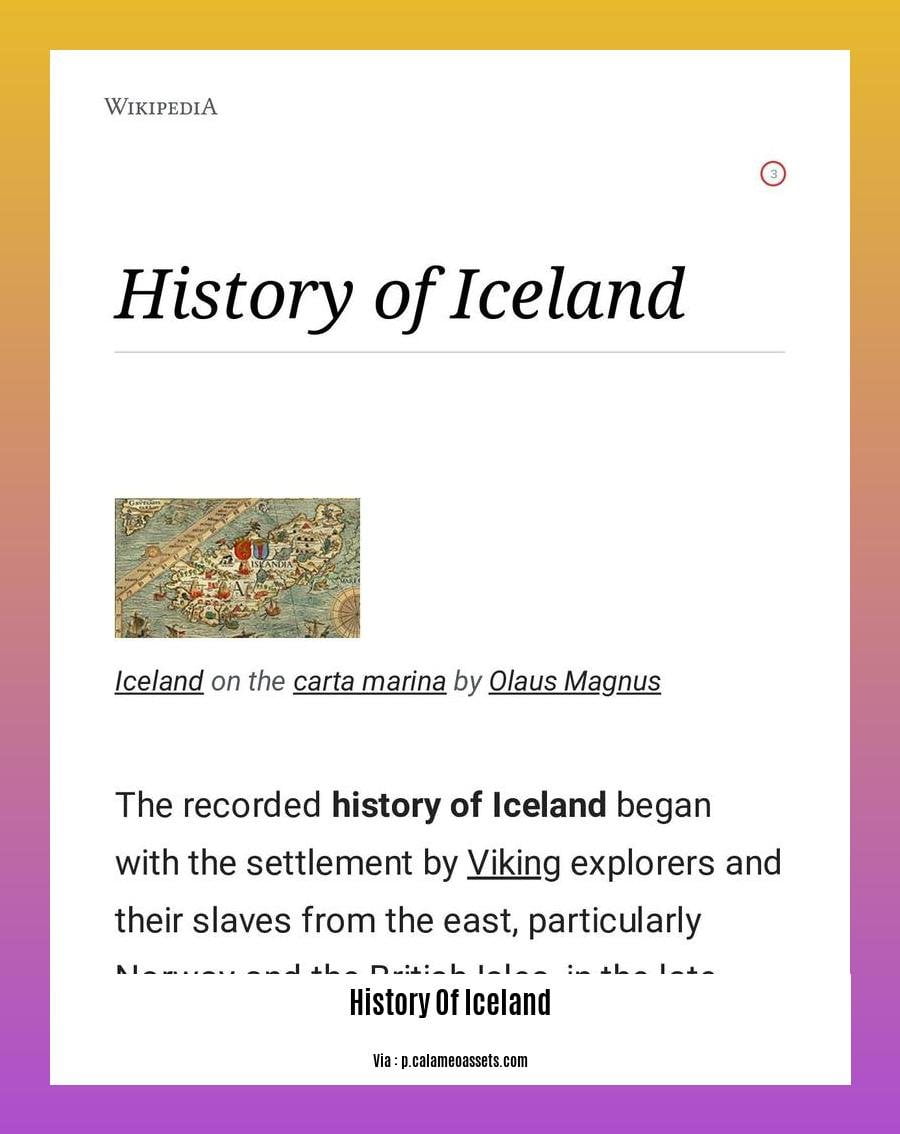
In this tapestry of time, we embark on a journey to Iceland, a land of striking beauty and captivating history. From its rugged landscapes to its resilient people, Iceland’s story is a testament to human endurance, cultural richness, and the power of survival.
H3: The Dawn of Settlement
Iceland’s history begins in the mists of time, when intrepid Norse and Celtic adventurers, driven by a thirst for exploration and new horizons, set sail from Norway in the Viking Age. These intrepid souls braved treacherous seas to reach this remote island, becoming its first settlers. With them, they brought their language, traditions, and dreams of a new life.
H3: A Unique System of Self-Governance
In a remarkable display of political innovation, the settlers established a unique system of self-government, one that would shape Iceland’s future for centuries to come. Local assemblies called “things” served as the foundation of this system, providing a forum for decision-making and dispute resolution. The “Althing,” a national parliament, was established in 930, becoming one of the oldest legislative bodies in the world. This ingenious system reflected the Icelandic spirit of independence and self-determination.
H3: Navigating Unions and Maintaining Identity
Over the centuries, Iceland’s fate became intertwined with that of its neighboring nations. It became part of Norway in 1262 and later joined the Danish-Norwegian Union in 1380. Despite these political shifts, Iceland fiercely maintained its language, culture, and legal traditions. This resilience would prove crucial in shaping the nation’s future identity.
H3: Facing Adversity with Strength and Resilience
Iceland’s history is not without its trials and tribulations. Volcanic eruptions, plagues, pirate raids, witch hunts, and poverty left their mark on the nation’s soul. Yet, through it all, Icelanders demonstrated extraordinary resilience and determination. They adapted to the harsh conditions, preserved their cultural heritage, and produced remarkable literature, art, and science. Their spirit of perseverance is an inspiration to us all.
H3: A New Dawn: Independence and Modernization
The 20th century brought transformative changes for Iceland. In 1918, it gained autonomy from Denmark, taking a significant step toward full independence. This long-held dream was finally realized in 1944 when Iceland declared independence and became a republic, marking a new chapter in its history. With newfound sovereignty, Iceland embarked on a path of modernization and economic development, transforming itself into a prosperous and progressive nation.
H3: Natural Beauty, Renewable Energy, and Social Progress
Today, Iceland stands as a beacon of natural beauty, sustainability, and social progress. Its stunning landscapes, including geysers, waterfalls, and glaciers, attract visitors from around the world. Iceland is a leader in renewable energy, harnessing its geothermal and hydroelectric resources to power its economy. The nation also boasts an impressive social welfare system, providing its citizens with healthcare, education, and other essential services. Iceland’s transformation from a remote island to a thriving modern society is a testament to the indomitable spirit of its people.
In the tapestry of time, Iceland’s history is a captivating narrative of human resilience, political innovation, and triumph over adversity. From its ancient origins to its modern achievements, Iceland’s story inspires us to embrace the challenges of the past and forge a brighter future for generations to come.
Want to go on an unforgettable journey of discovery and exploration? Delve into the captivating History of Iceland and Greenland to uncover the rich tapestry of Norse settlements, ancient sagas, and breathtaking landscapes that shaped these remarkable lands.
Iceland: History and Culture Today
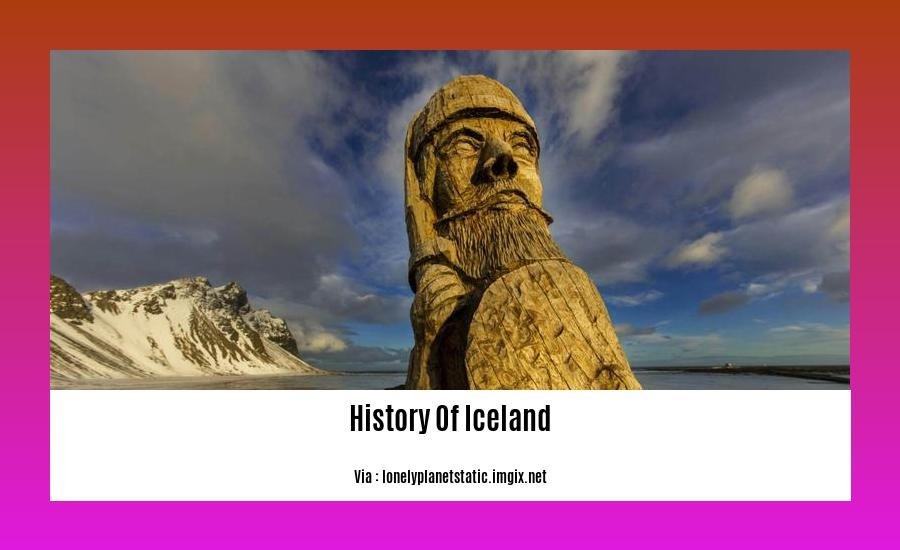
Key Takeaways:
Vibrant Viking heritage and unique traditions shape daily life in Iceland.
Icelandic culture embraces sustainability, equality, and strong connections to nature.
Explore Iceland’s remarkable past through historical sites, museums, and the breathtaking landscape.
Engage with the lively arts scene, from renowned literature to captivating music and stunning visual arts.
Experience the warmth and hospitality of the Icelandic people.
A Saga of Fire and Ice: The History of Iceland
Iceland’s history is as dramatic as its landscapes. From its volcanic origins to its Viking settlement and the subsequent struggle for independence, Iceland’s journey has been a captivating tale of resilience, innovation, and cultural preservation.
From Viking Roots to Modern Marvel:
Iceland’s rich culture is a tapestry woven from its Viking heritage, unique traditions, and modern influences. The people of Iceland take immense pride in their language, literature, and art, which showcases their deep connection to their past.
Sustainable Living in Harmony with Nature:
Iceland is a beacon of sustainability, harnessing its natural resources responsibly to meet its energy needs and protect the pristine environment. The country’s geothermal energy sources provide clean power, while its commitment to eco-friendly practices inspires global efforts toward a greener future.
A Cultural Tapestry of Art and Heritage:
Iceland’s creative spirit shines through its thriving arts scene. From the captivating sagas of old to the contemporary works of acclaimed authors, Icelandic literature captivates readers worldwide. Music, both traditional and modern, fills the air, while stunning visual arts exhibitions showcase the country’s natural beauty and cultural identity.
The Icelandic Spirit: Welcoming and Resilient:
The Icelandic people are renowned for their warmth, hospitality, and unwavering resilience. They embrace visitors with open arms, sharing their culture and heritage with a genuine desire to connect. Their ability to persevere through challenges, such as volcanic eruptions and economic downturns, reflects their indomitable spirit.
Iceland: A Timeless Tapestry of History and Culture
Iceland stands as a testament to the remarkable interplay between history and culture. Its captivating story, stunning landscapes, and vibrant arts scene make it a destination that captivates travelers and historians alike. Whether tracing the footsteps of Vikings or immersing yourself in the country’s modern marvels, Iceland offers an unforgettable journey through time and culture.
Citations:
Iceland Cultures, People and Traditions Guide
The birth of Iceland
The saga of Iceland’s origin is a tale of volcanic forces, daring seafarers, and a resilient spirit that echoes across the centuries. Let’s delve into the captivating narrative of how this Nordic gem came to be.
Key Takeaways:
- Iceland owes its existence to relentless volcanic eruptions that commenced approximately 20 million years ago.
- The island’s unique geological features, including the Mid-Atlantic Ridge and Iceland hotspot, shaped its dramatic formation.
- Viking explorers, accompanied by enslaved individuals from Western Europe, embarked on perilous journeys to settle Iceland in the late 9th century.
- A remarkable display of self-governance emerged with the establishment of the Alþingi (Althing), an assembly that convened annually at Þingvellir.
Our journey begins with Iceland’s fiery genesis, a testament to the Earth’s primordial power. Volcanic eruptions, fueled by the Mid-Atlantic Ridge and the Iceland hotspot, relentlessly sculpted the island’s rugged terrain. These ongoing geological processes continue to mold Iceland’s dynamic landscape, with new volcanic formations and geothermal wonders emerging.
In the late 9th century, intrepid Viking adventurers set their sights on Iceland, crossing treacherous waters in search of new frontiers. They brought with them a spirit of exploration, resilience, and a yearning for a new homeland. Accompanying the Vikings were enslaved individuals from Western Europe, adding a complex layer to the island’s early history.
These pioneers established settlements across the unforgiving terrain, laying the foundation for a distinct Icelandic culture. They brought their traditions, language, and a deep reverence for the natural world, which continue to shape Iceland’s identity today.
A pivotal moment in Iceland’s history occurred in 930 AD. The establishment of the Alþingi (Althing) marked the birth of one of the world’s oldest legislative assemblies. Convening annually at Þingvellir, a site of great natural beauty, the Althing served as a platform for decision-making and dispute resolution. Its creation reflected the Icelandic spirit of self-governance and democratic ideals.
These early settlers faced countless challenges in their adopted land. Volcanic eruptions, harsh weather conditions, and limited resources tested their resilience. Yet, they persevered, adapting to the unforgiving environment and forging a strong sense of community. Their legacy lives on in the vibrant culture and traditions of modern Iceland.
Sources:
[1] https://en.wikipedia.org/wiki/History_of_Iceland
[2]
FAQ
Q1: How did Iceland gain its independence?
A1: Iceland gained its independence from Denmark peacefully through a referendum held in 1944. This referendum resulted in the establishment of the Republic of Iceland on June 17, 1944.
Q2: What is the origin of Iceland’s population?
A2: The first permanent settlers of Iceland arrived in the late 9th century. These settlers were primarily Viking explorers and enslaved people from Western Europe, particularly from Norway and the British Isles. Genetic studies indicate that the majority of Iceland’s population today descends from these early Norse settlers.
Q3: What are some of the unique traditions and customs of Iceland?
A3: Iceland has various unique traditions and customs. For instance, the Icelandic language is one of the oldest Germanic languages and has remained relatively unchanged for centuries. Icelanders celebrate traditional holidays such as Þorrablót, a mid-winter feast held in late January or early February, and Sjómannadagur, a festival honoring seafarers, which takes place on the first Sunday in June.
Q4: How did the Alþingi (Althing) influence Iceland’s political development?
A4: The Alþingi, established in 930, was a significant assembly that convened annually at Þingvellir. It served as the governing body during Iceland’s Commonwealth period (930-1262). The Alþingi played a crucial role in shaping Iceland’s political and legal system, making it one of the oldest functioning parliaments in the world.
Q5: What is the significance of the volcanic activity in Iceland’s formation and geography?
A5: Iceland’s volcanic activity is a defining characteristic of its geological formation and geography. The island formed as a result of volcanic eruptions from the Iceland hotspot and the Iceland Plume. This ongoing volcanic activity has shaped the landscape, creating unique geological features such as geysers, hot springs, and lava fields. The volcanic activity also contributes to the island’s geothermal energy potential, making it a leader in renewable energy production.
- Unlocking Francis Alexander Shields’ Finance Empire: A Comprehensive Biography - July 12, 2025
- Unveiling Francis Alexander Shields: A Business Legacy - July 12, 2025
- Francis Alexander Shields’ Business Career: A Comprehensive Overview - July 12, 2025
